
ROEST web portal - track your roasting sessions
Being able to store, analyze, and compare your roasting session is a good way to learn, develop as a roaster, and improve your sample roasting experience. We have developed a web platform, where you can be in full control of your roaster and roasting session, do adjustments based on your preferences, and make sure you’ll get the most out of your ROEST sample roaster.
Being able to store, analyze, and compare your roasting session is a good way to learn, develop as a roaster, and improve your sample roasting experience.
We have developed a web platform, where you can be in full control of your roaster and roasting session, do adjustments based on your preferences, and make sure you’ll get the most out of your ROEST sample roaster.
In this article, we will highlight the different features of the web portal and how easy it is to manage.
“ The new portal looks amazing! I am super happy I picked ROEST. It’s so clear you all love what you do, and want to make an amazing product. Thank you!””
Not just a sample roaster
ROEST is a sample roaster known for its innovative technology and excellent user experience. It has a wide range of functionalities you get to access directly from the integrated touchscreen. But the real magic happens when you connect the roaster to WiFi and access the roasting web application: ROEST Web Portal. It’s an online web-based portal where you can create profiles, save and compare logs and follow your roasting session in real-time.
Easy to set up - no app needed!
ROEST sample roaster is a super easy roaster to set up, it’s basically Plug'n'Play. All you have to do when receiving your roaster is plug it in, connect to WiFi and log in to the web portal with the credentials you received along with your sample roaster. The ROEST web portal is an actual website - it can be accessed through any of your devices: phone, tablet, or laptop.
Multiple opportunities
The ROEST web portal has several different features which make the roasting session and your step toward the most accurate and consistent roasted coffee so much easier, and more fun. Let’s have a look at what you can explore inside the web portal.
1. Watch your sample roast live
With the web portal, you are in full control from the beginning to the end of your roasting session.
When you turn on the machine and the machine has reached the preferred start temperature, you drop the beans and the live view will start immediately.
You can monitor all the different parameters such as air temperature, bean temperature, rate of rise, and the various stages of the roasting process, from green to brown.
The live view will also give you a prediction of air and bean temperature, so you know what to expect.
When the first crack starts, the live view will tell you at which time this started and how many cracks you had before dropping the beans into the cooler.
When roasting back to back, you can use the live view as a layover on your previous log so that you can monitor and compare the roasting session at the same time.
Hover your cursor over the graph to see detailed information about the chosen parameters.
2. Store and analyze your roasting logs
Another feature that comes with the ROEST web portal is that it stores all of your roasting logs. This is so you can see everything you have roasted and collect all the information you need about that specific roast or compare it to other sessions.
Comparing logs comes in super handy if you have roasted a perfect batch of beans in the past, and experienced some differences with your current batch. Compare the two batches and see what happened this time, that made the difference, and hopefully, you will understand what caused the variation.
Comparing logs is useful to discover similarities, and differences and collect data.
To get an even closer look at your roasting logs, and go further into the analysis, you can zoom in on your log, so you get the most accurate and detailed information you need about your sample roast.
3. Create as many profiles as you want
Your ROEST sample roaster can store up to 5 profiles available even when roasting offline. You can create and download as many profiles as you want on the web portal. You can either create your own, based on your preferences or download profiles from the ROEST public profile library.
Upload and download profiles directly from ROEST public profile library.
Different types of profiles
Inside the web portal, you can create profiles based on:
Power input - setting a profile based on power.
Air temperature - setting a profile based on the air temperature sensor inside the drum.
Bean temperature - setting a profile based on the bean temperature sensor.
Inlet temperature - setting a profile based on the inlet temperature sensor.
Between Batch Protocol - resetting the thermal energy inside the roaster between batches.
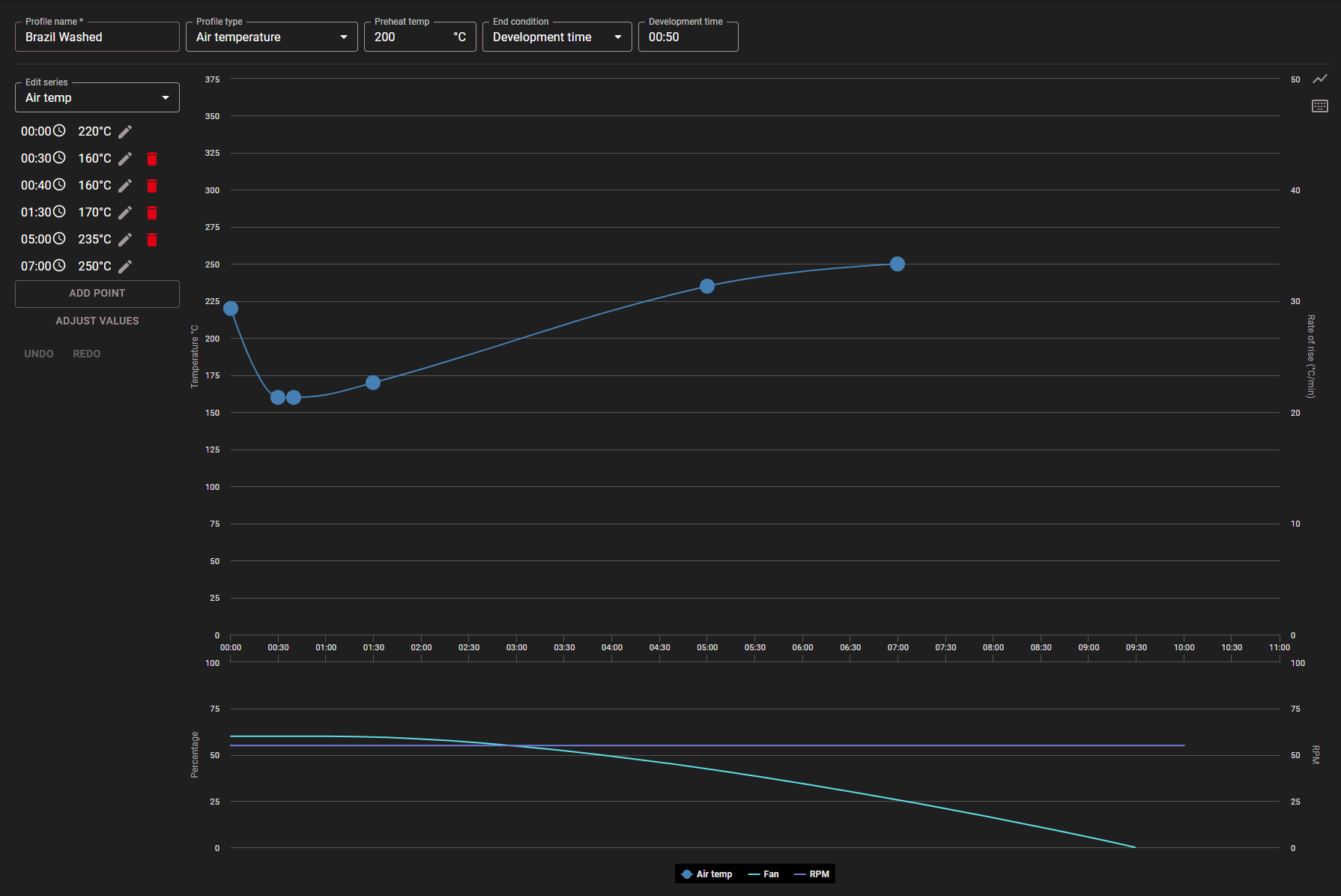
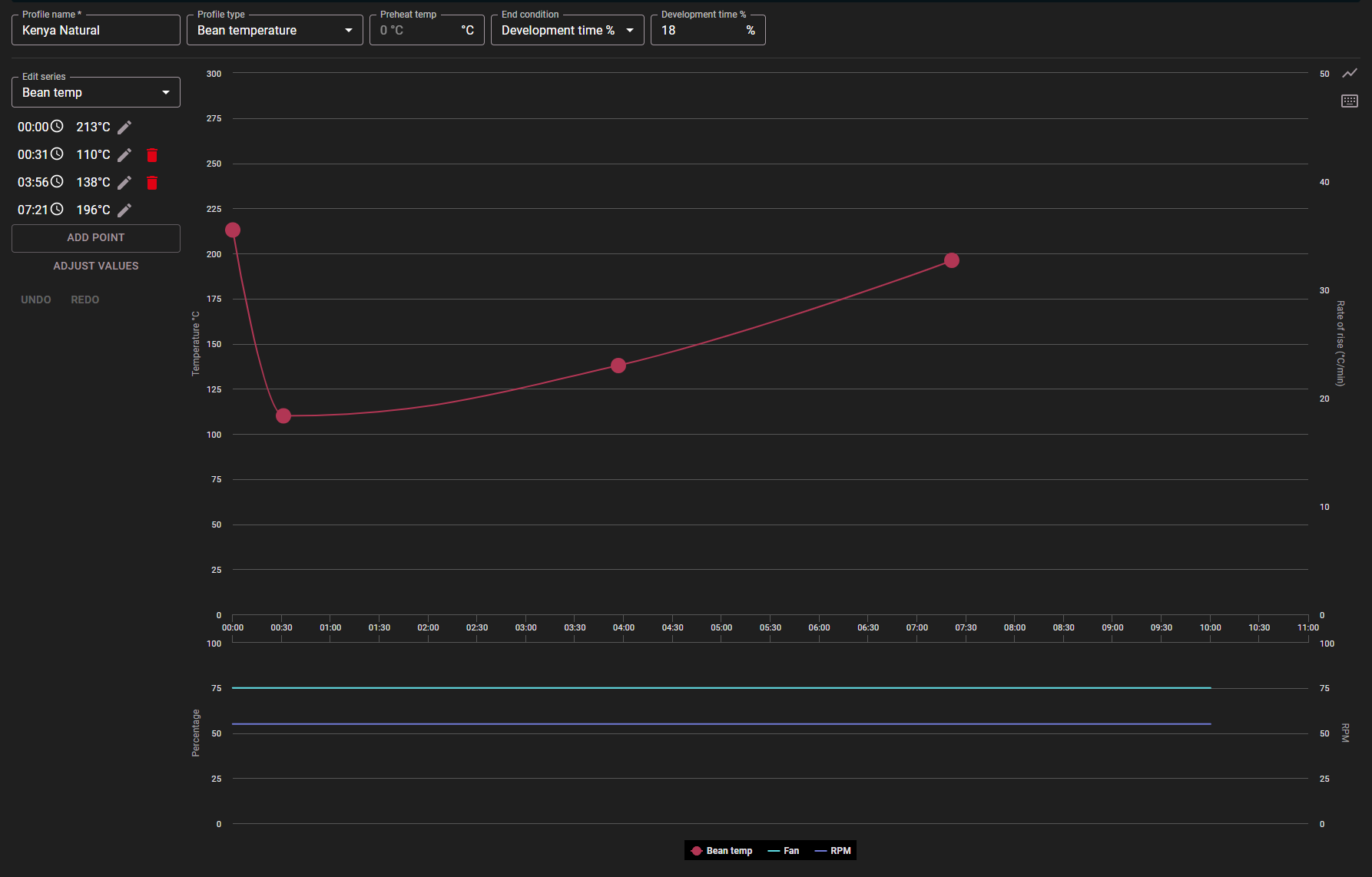
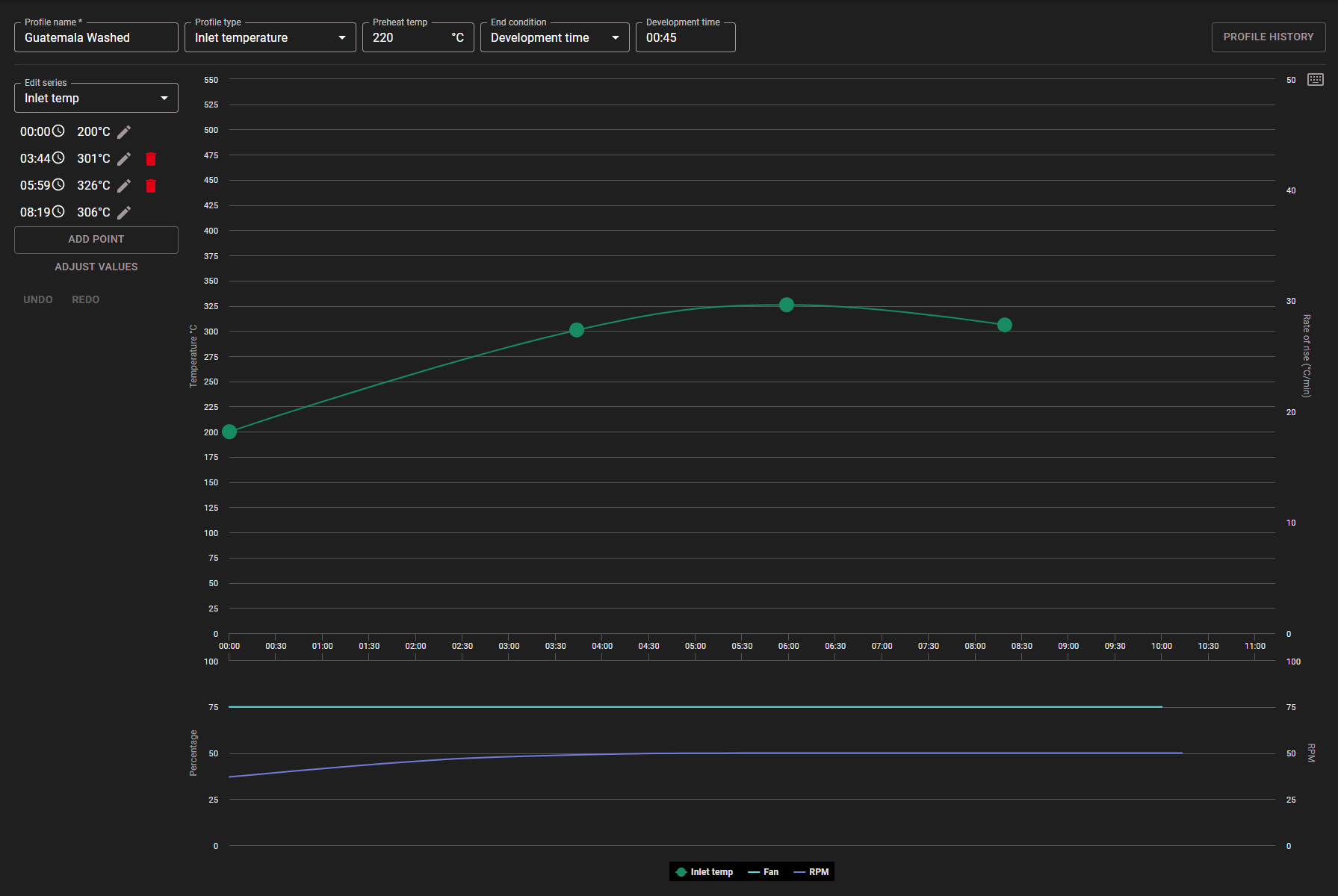
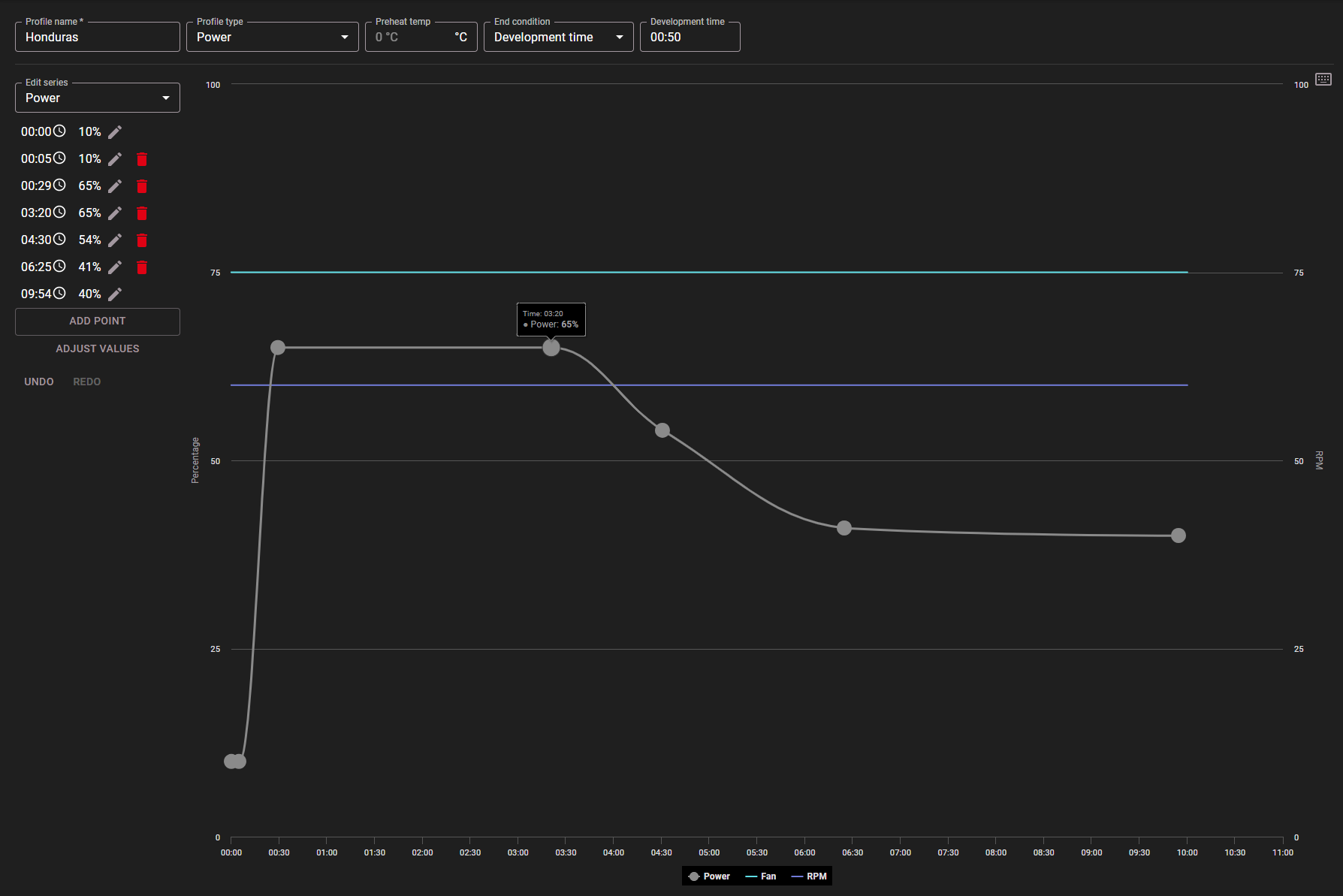
Between Batch Protocol
This feature allows the users to create a new type of profile: Between Batch Protocol profiles. This is to enhance consistency between batches and automate the process to make it easier. The ROEST sample roaster will notify you when it’s ready for you to drop the next batch.
Between Batch Protocol Profile
When creating a profile, every profile can have its own individual end conditions. You can choose to set the end time in:
1. Total time - the total amount of time from dropping the beans in the drum till it releases into the cooling tray.
2. Development time - the amount of time from when the machine starts to detect a certain number of first cracks till it drops the beans into the cooling tray.
3. Development time % - Development Time Ratio is calculated as time from First Crack to the end of the roast, as a percentage of total roast time.
4. Bean temperature - when the beans inside the drum have reached the preferred temperature.
If the end condition is not customized on your profile, the machine will do it by default setting.
4. Additional settings
The ROEST web portal is customizable so you can change settings to your preferences. An extra feature that you can adjust is the RoR interval - this one can be adjusted from 1 second up to 60 seconds.

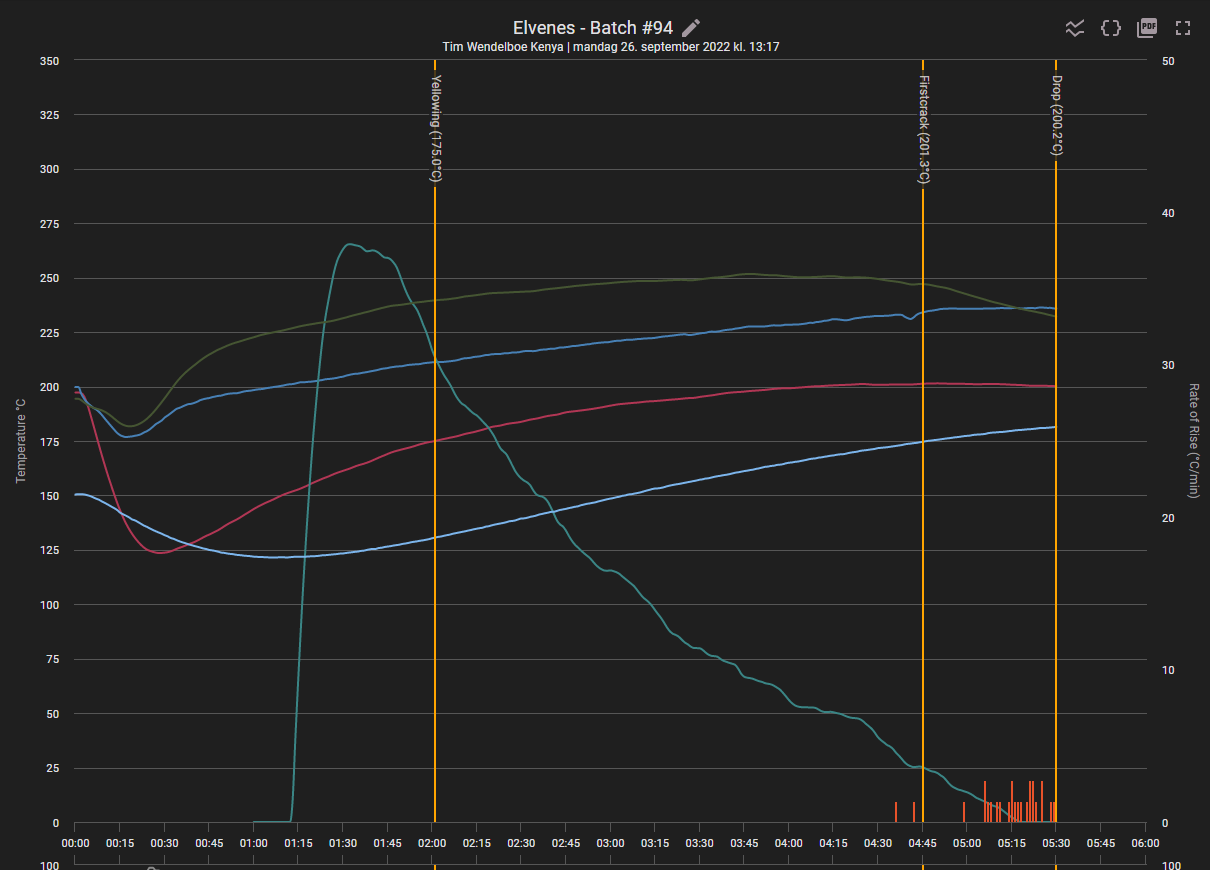
5. Cupping
Cupping is the most efficient way of evaluating coffee and the most exciting part of roasting. To make it easier and faster to assess your roasting sessions, we have developed a cupping feature inside the web portal.
You can choose from three different types of cupping forms; SCA, CoE, or a simple form made by ROEST. This gives you great opportunities to explore different ways to cup your coffee and hopefully become a better cup taster. Shortly, you will also be able to create cupping sheets that suit your specific needs.
Example of a cupping session using ROEST simple form.
6. green bean Inventory
One of the newest features inside the web portal is inventory. Here you can store all of your green beans, either it is samples or larger batches.
Keep track of your green bean inventory inside the web portal.
7. Public Profile Library
If you are new to roasting or want to explore other roasting profiles, we have now made it easy for you to download and upload profiles directly from our web portal. We want to create a space where everyone can roast coffee, develop their skill, and share their knowledge about coffee roasting.
Share and download profiles directly from the Web Portal
Constant Improvements
Our customers are important to us, and we always listen to their feedback. It’s thanks to them that we have implemented the most desired features and the reason that we regularly update our roasters all over the world.
We want to hear from you
We always strive to be better at what we do and what we can offer our customers. Is there a feature you are missing in the web portal? Let us know!
Enjoyed this? Then check out our article; 5 ROESTing tips from Tim Wendelboe
Have you recently purchased ROEST?
For a more detailed walkthrough of how to use the web portal, read more here.
Design to Repair: Sustainability at ROEST
Sustainability is one of the most important values for our coffee community. As we are growing, we feel a responsibility to focus more attention on what sustainability means to us and how we can contribute as a manufacturer. At ROEST, we are focused on creating a sustainable product for our customers, while building a sustainable business for our team.
In a world where technology is getting smarter for consumers, are we as manufacturers also getting smarter? Instead of producing more clutter, do we produce a bigger value?
At ROEST, we are focused on creating a sustainable product for our customers, while building a sustainable business for our team.
“Have you ever owned a product that’s become worthless because a small part has failed? I sure have, and as the CTO of ROEST I can promise you that will not happen with your ROEST.”
Our responsibility
Sustainability is one of the most important values for our coffee community. As we are growing, we feel a responsibility to focus more attention on what sustainability means to us and how we can contribute as a manufacturer.
We live in a world of “this year’s model”- a desire to always own something newer and better. The team behind ROEST is no different, we also have a desire to own something better. And we acknowledge that our customers can have this desire as well.
improvements
Our approach to sustainability is therefore to make all improvements available for our customers, both existing and new comings, so that they can upgrade their roasters themselves instead of buying a new one.
The new fan impellers (on the left) are far superior to the old design (on the right). Made from a stronger material with improved design making them stronger, easier to clean and service.
Built to last
For us, repair stands for designing and manufacturing products with longer durability and repairability. Sverre Simonsen: “Have you ever owned a product that's become worthless because a small part has failed? I sure have, and as the CTO of ROEST I can promise you that will not happen with your ROEST.” Our roasters are engineered to last longer because they can be repaired. This is better for us, our customer and for the environment.
FIX IT YOURSELF
The development team at ROEST is constantly increasing the quality of our product. At the same time, we want our customers to be able to handle repairs themselves. And you know what? It’s fun and rewarding to repair something and to make it last longer!
Brothers Trond and Sverre built ROEST for easy repairs so it’s better for us, our customers and for the environment.
Products using smart technology to assist you can be of tremendous help, but they can also fail or need an upgrade. Luckily, there is no need to panic. The repairability of ROEST means you don’t need to send your sample roaster back to our production facility. You can fix it yourself. And to avoid the headache of not being able to roast for several days, we commit to fully online support to help you resolve the problem.
Krzysztof from the Hard Beans roastery in Poland experienced the technical support when his power suddenly dropped: “I've contacted the Support Team and according to the behavior of the machine they localized the issue. Right afterwards the Support Team prepared the shipment of the spare part heating element which arrived within 48 hours. In the meantime I've received manuals and tutorial videos how to replace the part correctly without damaging other parts. When the package arrived, with additional parts and necessary elements I've easily replaced the heating element. In the end the Support Team via the Internet double checked the software settings.”
Accessibility of spare parts
Design for repair also means that spare parts are readily available and accessible, both from us, our producers, or some of the global suppliers we use.
the right suppliers
Finding the right suppliers has been a time-consuming process for us, but we think it is important from a sustainability point of view. In addition, this means we find producers that can produce high-quality products with a low “scrape rate” , meaning that the vast majority of the parts we receive can be used. This also benefits our customers, as the parts we place inside ROEST are of very high quality, providing a long service life.
“Our customers welcome the idea of being able to fix the machine themselves instead of going through troubles of sending it back and losing the time without a sample roaster.”
OPPORTUNITY FOR CUSTOMERS
The exciting part about buying a ROEST, is the focus on understanding how the machine actually works - not only when you use it for roasting the coffee. We encourage our customers to not be afraid of opening the roaster to fix problems, do maintenance or installing new features. You can learn so much, and you can get assistance with our guidance, service manuals and video tutorials. The best part - you don’t need any super skills, and the tools you need you probably already own.
Nat Huadsoontorn in Thailand also ran into a small issue and was surprised how easy it was to replace a spare part: “I replaced the ventilation fan - the good thing is on the touchscreen of ROEST it was saying - Venting fan Error - so I knew which part faced a problem. It’s nice to be able to fix a roaster by myself. It’s like a shortcut - in about 20 minutes I was roasting again.“
Investment for the future
When investing in professional equipment, customers should have in mind the value of the product, and not only its features and design. Customer support and service details are what is often underestimated before the purchase.
Julia Richardson, Head of Sales at ROEST is daily in contact with our clients: “Our customers welcome the idea of being able to fix the machine themselves instead of going through troubles of sending it back and losing the time without a sample roaster.”
So, what is the true value of a ROEST sample roaster, besides its unmatched features?'
Easy to repair: service manuals, tutorials, e-shop with spare parts
Free online customer support
One year warranty, with free spare parts. After one year you only pay for the parts and customer support remains free.
ROEST sample roaster comes with free spare heating element and basic tools
Free firmware and software updates
Possibility to upgrade parts as we continue to improve the roaster and its features
Recycle
While it's still a long time until the first ROEST needs to retire, it is good to know that we have chosen materials that are easy to recycle. The majority of the parts in ROEST are already containing recycled materials. And we chose materials that have a natural finish, like brushed stainless steel. We do this not only because it looks good, but because it's the sustainable choice.
Nordic roasting style
The Nordic roasting style can simply be described as a lighter roast. Specialty coffee is roasted light by default in comparison with commercial grade coffee.
Does this mean the Nordic style is lighter than others? What’s this trend actually about?
In 2014, when I lived in Prague, we were always so excited to taste coffees from Norwegian specialty coffee roasters. It felt so exclusive and rare. Yet the excitement was gone after tasting the cup. Flat is the word we would use to describe the experience. It was nothing like we were used to within our market.
Today, I have been in Norway for two years, and the local coffee is complimenting my taste buds.
Bjørnar Hafslund, founder of Brattestø roastery, has been roasting since 2006. He says: “I would like to compare the coffees I roasted in 2006 and now. I am sure they were extremely underdeveloped.”
Is that the Nordic roasting style?
Norway is known as the world’s second largest consumer of coffee. Coffee rituals are tied to long summer days: cooking coffee at the hytta (cabin) deep in the beautiful northern nature.
A country with over 80 roasteries and home to World coffee champions, Norway is well-known for the trend of Nordic roasting style. The Nordic roasting style can simply be described as a lighter roast. Specialty coffee is roasted light by default in comparison with commercial grade coffee.
Does this mean the Nordic style is lighter than others? Or is there more to it?
I talked with Norwegian roasters and roasters outside Norway who follow this style, to understand where it started and the secret behind it.
Where it came from
Scandinavian or Nordic?
Simo Kristidhi, the Head roaster at Solberg & Hansen, explains: “Norwegian roast is the one that is the closest to what we nowadays call Nordic roast, as it has always been lighter. In comparison, Sweden and Finland have an excessive darker roast.”
The idea of the Nordic roasting style started around 20 years ago, along with the rise of specialty coffee in the Nordic countries. The very first world barista championships, Nordic Barista cup or Nordic Roaster, are among the most important events that shaped the local coffee industry. Specialty coffee roasteries and personalities have a huge impact on the way the local market evolved: Tim Wendelboe, Solberg & Hansen, Kaffa or people like Andreas Hertzberg, and many others, played important roles.
Nordic roaster forum gathers coffee experts from around the world to join the lectures from coffee buyers, roasters and producers. Photo credit: http://nordicroasterforum.com/
Bjørnar remembers when Trish Gothreb, the first roaster at Mocca roastery (currently Kaffa), came to Norway with her (back then, controversial) roasting style: “The roast level she had was so light in comparison to what the industry was used to. Everyone was sceptical. And the fact is, compared to today’s standards, it wasn’t even so light.”
KAFFA roastery, photo from 2012. Photo credit: Kaffa
Roasting coffee lighter is only possible when roasting high-quality coffee. Otherwise, we are risking unpleasant outcomes. Because of a trade exchange with Brazil in the early 19th century, Norway could access high-quality coffee in exchange with fish.
Bjørnar plays with the idea of Norwegian acquired taste: “Norwegians are more accustomed to food with higher levels of acidity. Because of our cold climate, the fruits that dominate our fauna are apples and berries.”
Brewed coffee in Norway is like an espresso in Italy: It comes with a strong tradition. And lighter roast fits brewed coffee the best.
The idea behind
There are different roasting styles in the world. In Asia, you will experience specialty coffee roasted darker than the Nordic roasting style. As well as in North America: “I'd say, on average the 'American' style of roasting is still darker than the average Nordic roasting style, especially within specialty roasters”, says Lance Schnorenberg, the head roaster of SEY coffee in New York.
Most of the roasters have their own style or strategy for roasting coffee. This could be the way they approach beans, and what they are aiming to develop in the cup.
When trying to define the Nordic style, what I found similar is the aim for flavour development, and the unique taste experience when looking for the right profile for each coffee.
SEY coffee in New York is famous for roasting coffee the Nordic style, and the head roaster Lance explains: “I like to think about roasting or development as trying to be as transparent as possible. This is probably in line with the Nordic or Scandinavian style. We try to roast in a way that is as clear a representation of the coffee and terroir as we possibly can.”
Simo describes the idea behind the Nordic roasting style: “…to showcase the potential of the bean, taking in consideration the origin, the variety, the process and terroir. The result is an enormous differentiation of taste attributes between origins, lots and varieties, instead of delivering a coffee that tastes just coffee.”
Sounds like the ideal roasting style, doesn’t it? So why isn't everyone roasting this way?
Roasting coffee lighter can be tricky. If you stop the roast too soon, the taste will not quite develop. The result will be a green and underdeveloped cup.
Nordic style is not only about roasting light, or quickly, as some have described it. Simo explains with an example: “A perfect Nordic style Kenyan coffee can be roasted at a certain colour development within 8-9 minutes, while a Colombian coffee can be roasted at a different colour development at 9:30-10 minutes. Which means that this style is not only about the fast and light roasts. It’s about taste and at which point this coffee will be the most developed and complex.”
Photo credit: Photography Paul Lockhart
“We (coffee professionals) like and seek light roasted coffee that represents the farm, terior, variety... Maybe it drives back to the Nordic countries who started the trend, but that trend has grown worldwide. What makes us stand out is that since it originated here (in Norway), we have a responsibility to keep that going strong in terms of consistency, skill of roasted coffee, and interesting coffee origins. Therefore in our roastery it all comes down to: hard work and passion, cupping constantly, and always being students of coffee.”
Adrian Seligman, Founder of Scandinavian Alps Roastery
Future of the roasting style
What is the future of the specialty coffee industry on the roasting level? The rise of smart technology, especially in roasting, allows us to control many useful parameters. For example, with our ROEST sample roaster you can measure bean or environmental temperature, adjust drum speed, power, and fan. The more information you can get from the roaster, the more you can improve your roasting skills.
Simo Kristidhi trying out sample roasting on ROEST during the Norwegian roasting championship 2019.
Nowadays, we can also learn more about roasting from the educational events and roasting courses that are getting more and more available: “The forums, such as Nordic roasters, revolutionized the global roasting community, spreading knowledge and educating the new generation,” explains Simo. “Still, there is a big gap from roastery to roastery in how they interpret and perceive the development level of the coffee. Unfortunately, some of the coffee is quite underdeveloped. For that reason, I believe that many roasters will improve their profiles to deliver a cup that is up to the expectations of the Nordic Style.”
Lance adds: “People are learning, and once people drink coffee with acidity and learn to appreciate it, it's generally very difficult to go back to drinking coffee that doesn't have it.” After all, the coffee industry is (and will be) about the customers.”
If you ever go to Zürich, make sure to stop by at MAME coffee shop where you will have delicious coffee, served by awarded baristas. And please note the quote in the window, which I believe will always remain the most important factor regarding coffee, no matter what style you roast:
“The best coffee is the coffee you like!”
Written by
Veronika Galova Vesela, Marketing Manager of ROEST



















